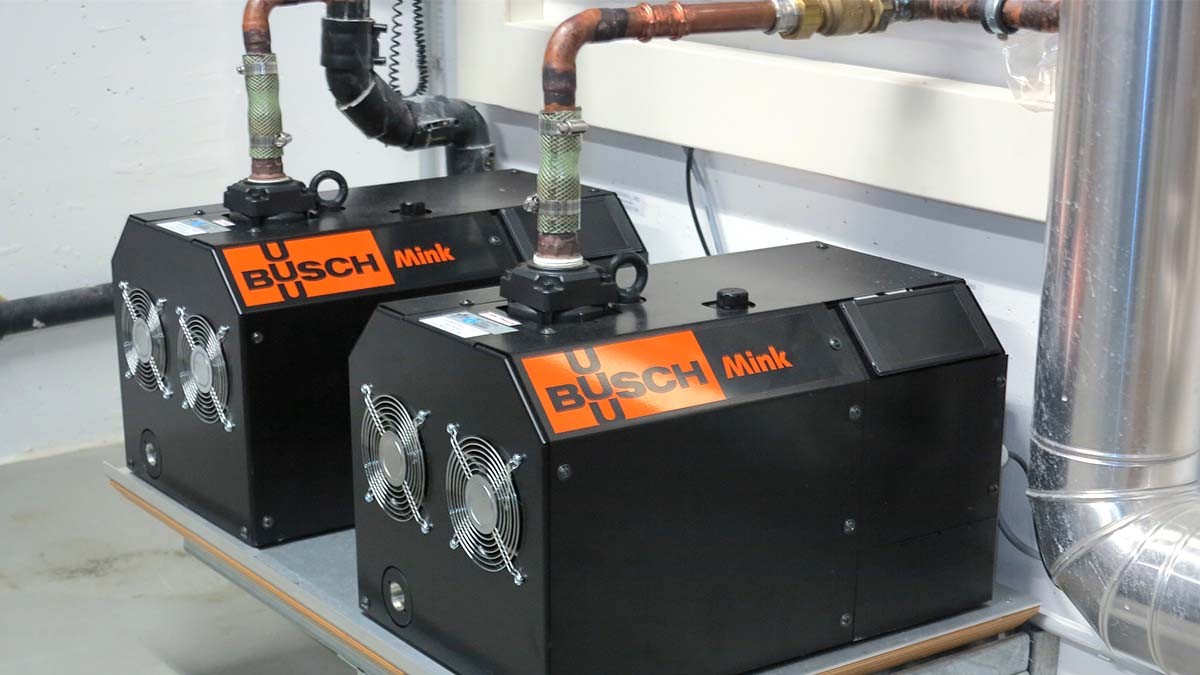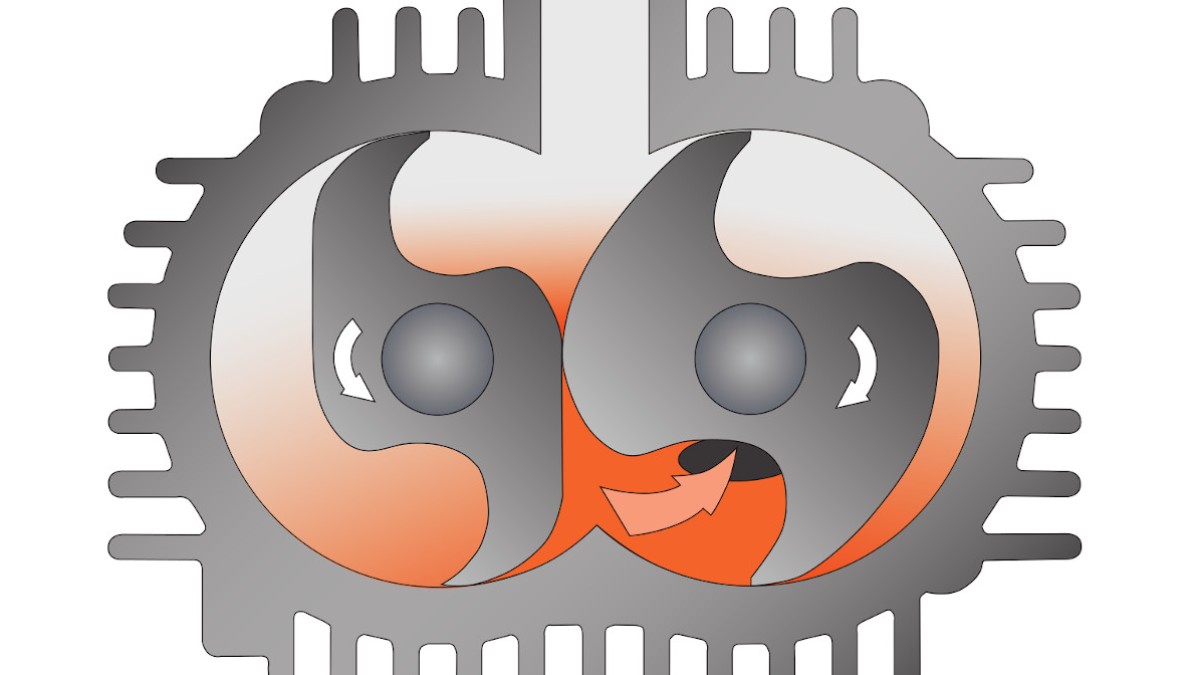At the José-Carreras Centre for Somatic Cell Therapy at the University Hospital Regensburg, it is imperative that the particles in the air in clean rooms are measured continuously and reliably.
The isokinetic sampling is carried out at five sterile workbenches, with the number of particles measured across a defined air flow. The air flow is generated by MINK MV claw vacuum pumps from Busch Vacuum Solutions. These have an intelligent drive that allows the exact volume of air required to flow past the measuring probe, while ensuring that there is never an irregularity, malfunction or failure after a year of operation as of May 2015.

Two redundant MINK MV claw vacuum pumps from Busch in the engineering room of the laboratory center. Source: Busch Vacuum Solutions.
Dependable Vacuum Supply for Isokinetic Sampling in Clean Rooms
José-Carreras Centre for Somatic Cell Therapy at the University Hospital Regensburg
Isokinetic sampling
For the aseptic production of medicinal products – which also include the cell therapy products produced at the JCC – the EU guideline for good manufacturing practice (EU GMP guideline) stipulates that the number of particles must be continuously monitored in clean room class A – the highest class.In clean room class A, the particles are measured directly at the five sterile workbenches by means of permanent isokinetic sampling. A partial flow is extracted from the air via the particle counter, which must be exactly one cubic foot/minute (1 cfm) or 28.3 liters per minute. The particle counter uses a laser to measure the number of particles per defined air volume, and transfers the measured values to an independent monitoring system where the permissible thresholds are stored. If a threshold is exceeded, the system triggers a visual and acoustic alarm.
However, it is not only the number of particles that are monitored by the monitoring system, but also the adherence to the prescribed flow rate at the individual particle counters. After all, this is the only way to ensure that the measured values are evaluated correctly against the thresholds per cubic meter of air as defined in the EU Good Manufacturing Guideline (GMP). The system also emits an alarm (flow alarm) as soon as the prescribed flow rate is exceeded or falls short.
The original solution
Originally, a dry-running rotary vane vacuum pump was used for each separate particle counter, which generated the flow rate.There were two major disadvantages to this system:
- Firstly, it had no redundancy. If one vacuum pump were to fail, it was no longer possible to use the associated particle counter, and as a result the entire sterile workplace was out of use.
- Secondly, it was not possible to regulate the old pumps, meaning that it was not possible to compensate for fluctuations in the flow rate – and so this would constantly result in flow alarms.
Furthermore, the vacuum pumps started to show considerable signs of wear after just a few years and would have to have been exchanged successively.
For the head of operations at the laboratory center, Dr Andrea Hauser, this was an unacceptable state of affairs, especially since any disruptions to the continuous particle monitoring are extremely critical when it comes to the production of pharmaceuticals.
After each "flow alarm", a time-consuming troubleshooting and analysis procedure had to be carried out and, if necessary, the particle counters then had to be sent off for inspection and recalibration. This was very costly in terms of both time and money, and in fact was more costly than the price of a new vacuum pump.
These are also equipped with an intelligent drive with a frequency converter, which enables the vacuum pumps to be regulated such that they permanently operate at the required performance, even if the process conditions change.
In May 2014, two MINK MV 0040 D claw vacuum pumps were installed in the technical center of the JCC and operated redundantly. This means that only one of the two vacuum pumps is in operation, while the other acts as a stand-by. The two new vacuum pumps are programed to maintain a precise standard flow of 28.3 liters per minute at the particle counters. The entire control system for the vacuum pumps was programmed and implemented internally by operating technician Bernhard Horn.
After each "flow alarm", a time-consuming troubleshooting and analysis procedure had to be carried out and, if necessary, the particle counters then had to be sent off for inspection and recalibration. This was very costly in terms of both time and money, and in fact was more costly than the price of a new vacuum pump.
Centralization of the vacuum supply
Operating technician Erich Six therefore contacted Busch Vacuum Solutions, and together they developed a new concept: a central vacuum supply for all particle counters using two vacuum pumps, which operate according to the MINK claw vacuum principle.These are also equipped with an intelligent drive with a frequency converter, which enables the vacuum pumps to be regulated such that they permanently operate at the required performance, even if the process conditions change.
In May 2014, two MINK MV 0040 D claw vacuum pumps were installed in the technical center of the JCC and operated redundantly. This means that only one of the two vacuum pumps is in operation, while the other acts as a stand-by. The two new vacuum pumps are programed to maintain a precise standard flow of 28.3 liters per minute at the particle counters. The entire control system for the vacuum pumps was programmed and implemented internally by operating technician Bernhard Horn.
Further advantages of MINK claw vacuum pumps:
Both vacuum pumps are connected to the building control system and constantly monitored, with any malfunctions immediately displayed. The vacuum system is in use around the clock, with the control system designed by the technical center of the university hospital in such a way that the vacuum pumps operate alternately and therefore both spend the same amount of time in operation. In the event that one of the vacuum pumps malfunctioned, the control system would immediately ensure that the other pump springs into operation and the vacuum supply does not fail.
- MINK claw vacuum pumps operate dry, meaning that they are free from operating fluids in the compression chamber and operate contact-free.
- Unlike dry-running rotary vane pumps, there is no wear, thanks to this method of contact-free operation.
- It is another reason why this type of vacuum pump permanently generates the required pumping speed. The operation without operating fluids and without wearing parts makes the Mink claw vacuum pump virtually maintenance-free.
Both vacuum pumps are connected to the building control system and constantly monitored, with any malfunctions immediately displayed. The vacuum system is in use around the clock, with the control system designed by the technical center of the university hospital in such a way that the vacuum pumps operate alternately and therefore both spend the same amount of time in operation. In the event that one of the vacuum pumps malfunctioned, the control system would immediately ensure that the other pump springs into operation and the vacuum supply does not fail.
-

Operating principle of a MINK claw vacuum pump. Contact-free and without operating fluid in the compression chamber. Source: Busch Vacuum Solutions.
This new vacuum technology has been in operation at the José-Carreras Centre since May 2014, and so far there have been no "flow alarms" in the clean room or any other malfunctions or disruptions to the vacuum supply.
Furthermore, until now, no maintenance work has been required on the vacuum pumps. Dr Andrea Hauser and operating technician Erich Six are confident that the MINK vacuum technology has provided the perfect solution for their vacuum generation.
Furthermore, until now, no maintenance work has been required on the vacuum pumps. Dr Andrea Hauser and operating technician Erich Six are confident that the MINK vacuum technology has provided the perfect solution for their vacuum generation.
About José-Carreras Centre for Somatic Cell Therapy
Built in 2008 and 2009, the José-Carreras Centre for Somatic Cell Therapy (JCC) is a specialist center for the pharmaceutical development and production of cell therapy products. It is a facility of the University Hospital Regensburg, located in the Clinic and Polyclinic for Internal Medicine III. The construction of the center was funded by the José-Carreras-Leukämie-Stiftung e.V., by the European Union as part of its regional support, and by the University Hospital Regensburg. The center offers all technical possibilities for the development of modern cell-based therapeutic approaches for applications within clinical trials, and therefore represents an important infrastructural premise for numerous translational research projects, both at the university hospital and beyond.